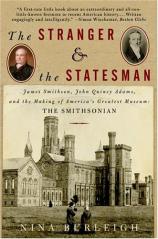The Stranger and the Statesman: James Smithson, John Quincy Adams, and the Making of America's Greatest Museum: The Smithsonian
Review
The Stranger and the Statesman: James Smithson, John Quincy Adams, and the Making of America's Greatest Museum: The Smithsonian
Over 20 million people visit the Smithsonian Institution each year;
its collections of cultural and educational exhibits are globally
unrivaled. Yet little is known about how the museum came to be, a
question Nina Burleigh tries to answer in THE STRANGER AND THE
STATESMAN. After reading Burleigh's ambitious book, one comes away
more knowledgeable not only about the man himself, but also about
the mores peculiar to his day that influenced his philosophy.
James Smithson, born Jacques Louis Macie in France in 1765, was the
bastard son of Elizabeth Macie, a rich English widow, and Hugh
Smithson, the Duke of Northumberland. The young Macie, who later
changed his name to reflect his paternal side, grew up in a society
where birth rank followed a very exact hierarchy. In those days,
the eldest son of a noble gained the most in terms of wealth and
status. By virtue of his uncontrollable circumstances, Smithson
(who is often referred to by the author as "nobody's child") was
relegated to a position in which he nevertheless led a life full of
privilege and comfort. That his father never formally acknowledged
him was made less difficult by the fact that his mother, an astute
businesswoman, did quite well on her own.
Macie/Smithson's education led to a career, if it could be called
such, in the sciences, specifically as a geologist. Burleigh
describes the quaint scientific methods and it's amazing, in
retrospect, that anything was accomplished using the relatively
primitive tools of the time.
Smithson had no immediate family of his own to speak of. Upon his
death in Italy at the age of 64 (his life was described as being
spent mostly in poor health), he left the bulk of his fortune ---
the modern equivalent of $50 million --- to go towards the
establishment of a body that would promote "the increase and
diffusion of knowledge". . . in the United States!
Naturally, there was a great deal of judicial wrangling as several
distant relatives contested the will. Why would he name the U.S. as
his "beneficiary?" Smithson had never visited the fledgling nation,
nor did he leave any clues behind as to the reasons behind his
magnanimous gesture.
How would the fortune be spent? This argument was divided along
political lines. Northern and Southern states were already deeply
into the rifts of slavery. Southern politicians did not want the
funds used to build a "national" entity, demanding the money be
split in such a way to best suit individual states. Northerners,
not surprisingly, disagreed.
John Quincy Adams's role in THE STRANGER AND THE STATESMAN seems
mainly to serve as Smithson's kindred spirit across the ocean. The
ex-president was by that time a member of Congress. He had long
entertained grand visions of America as "the new Athens" and
spearheaded the efforts, against tremendous pressures, to put
Smithson's largess to its intended use.
Of equal import in this strange story (which begins with a grisly
account of Alexander Graham Bell traveling to Italy to bring
Smithson's remains to the United States) is the role of Richard
Rush, an American diplomat who spent several years waiting out the
Italian court system in the final disposition of Smithson's will
and bringing "the gift" --- in the form of over one hundred bags of
gold --- to the U.S.
It is obvious that Burleigh conducted extensive research for THE
STRANGER AND THE STATESMAN. Unfortunately, she leaves many
questions unanswered. She hints, but does not come right out and
say, that Smithson may have been insane towards the end of his life
(as one possible explanation). What was his reasoning in
designating his fortune for use in America, rather than bequeathing
it to the Royal Academy? Was he truly taken seriously as a
scientist, earning the respect of his peers? If not, that
might have been a reason. Or was it because he was so impressed
with statesman/scientist Benjamin Franklin, who had visited Europe
on several occasions (although the two never met)?
Burleigh might have had a better chance of answering these
questions had the original Smithsonian, containing whatever papers
its benefactor left behind, not been destroyed in a fire in 1865.
This catastrophe helped in creating "the Smithson Mystery," and
allows readers of THE STRANGER AND THE STATESMAN to wonder about
the motives of this strange and quiet man.
Reviewed by Ron Kaplan (RonKaplanNJ@comcast.net) on January 23, 2011
The Stranger and the Statesman: James Smithson, John Quincy Adams, and the Making of America's Greatest Museum: The Smithsonian
- Publication Date: September 28, 2004
- Genres: History, Nonfiction
- Paperback: 320 pages
- Publisher: Harper Perennial
- ISBN-10: 0060002425
- ISBN-13: 9780060002428



